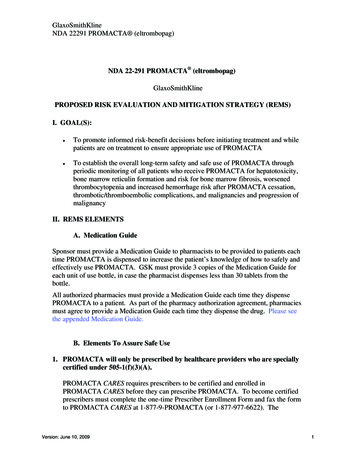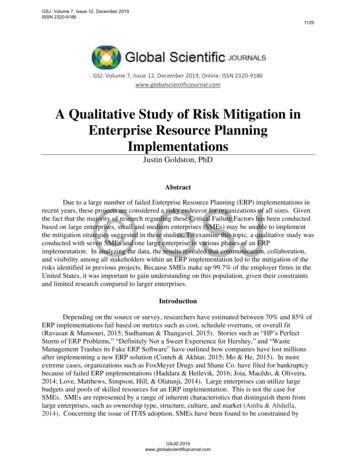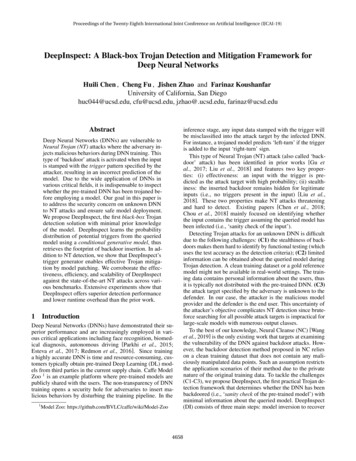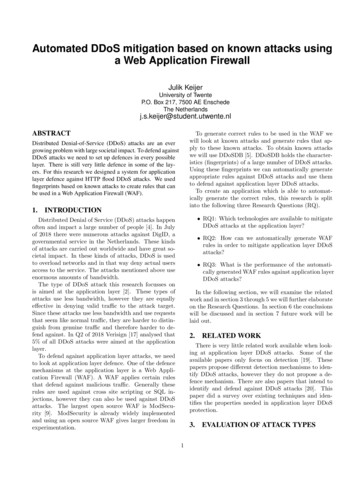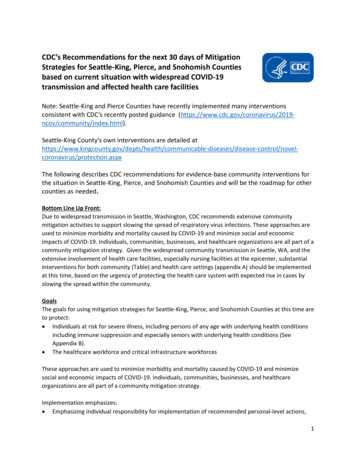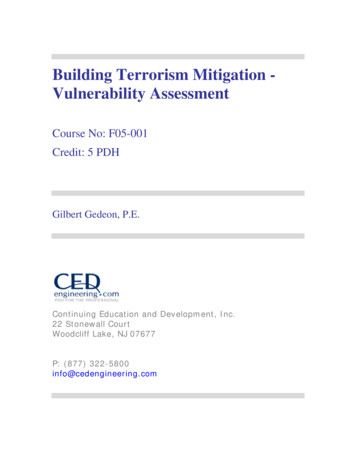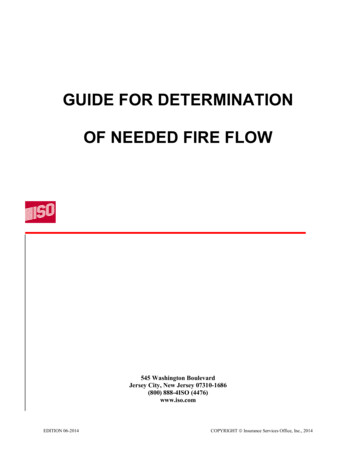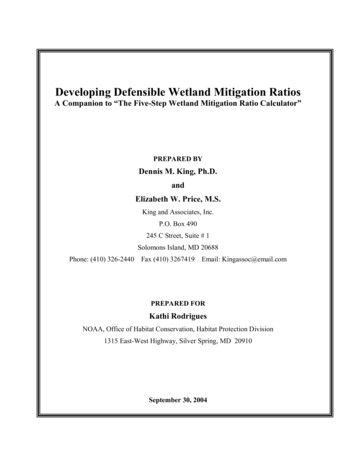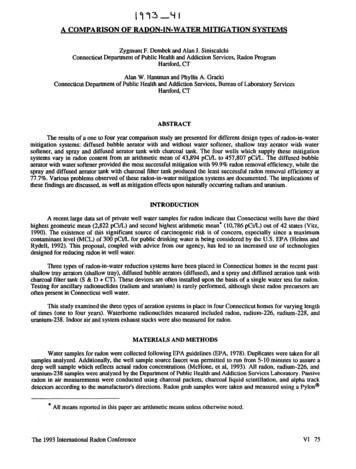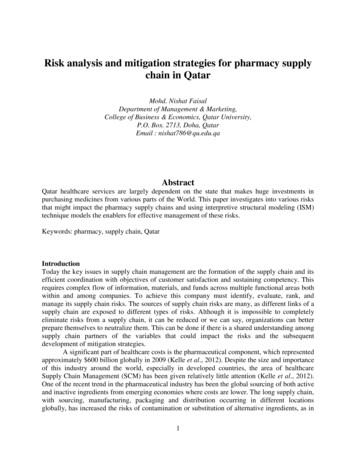
Transcription
Risk analysis and mitigation strategies for pharmacy supplychain in QatarMohd. Nishat FaisalDepartment of Management & Marketing,College of Business & Economics, Qatar University,P.O. Box. 2713, Doha, QatarEmail : nishat786@qu.edu.qaAbstractQatar healthcare services are largely dependent on the state that makes huge investments inpurchasing medicines from various parts of the World. This paper investigates into various risksthat might impact the pharmacy supply chains and using interpretive structural modeling (ISM)technique models the enablers for effective management of these risks.Keywords: pharmacy, supply chain, QatarIntroductionToday the key issues in supply chain management are the formation of the supply chain and itsefficient coordination with objectives of customer satisfaction and sustaining competency. Thisrequires complex flow of information, materials, and funds across multiple functional areas bothwithin and among companies. To achieve this company must identify, evaluate, rank, andmanage its supply chain risks. The sources of supply chain risks are many, as different links of asupply chain are exposed to different types of risks. Although it is impossible to completelyeliminate risks from a supply chain, it can be reduced or we can say, organizations can betterprepare themselves to neutralize them. This can be done if there is a shared understanding amongsupply chain partners of the variables that could impact the risks and the subsequentdevelopment of mitigation strategies.A significant part of healthcare costs is the pharmaceutical component, which representedapproximately 600 billion globally in 2009 (Kelle et al., 2012). Despite the size and importanceof this industry around the world, especially in developed countries, the area of healthcareSupply Chain Management (SCM) has been given relatively little attention (Kelle et al., 2012).One of the recent trend in the pharmaceutical industry has been the global sourcing of both activeand inactive ingredients from emerging economies where costs are lower. The long supply chain,with sourcing, manufacturing, packaging and distribution occurring in different locationsglobally, has increased the risks of contamination or substitution of alternative ingredients, as in1
the case of the 2008 heparin accident (Maruchek et al., 2011). For a pharmacy supply chain, theinterest is not simply the physical processes of conversion and distribution of materials butequally important is the “value-chain” perspective of managing the innovation and developmentprocesses through to capacity and production planning (Shah, 2004).Interpretive Structural Modeling (ISM) can be used for identifying and summarizingrelationships among specific variables, which define a problem or an issue (Warfield, 1974;Sage, 1977). In this paper, the enablers of the risk mitigation in pharmacy supply chains havebeen analyzed using the ISM methodology, which shows the interrelationships of the enablersand their levels. These enablers are also categorized depending on their driving power anddependence.The main objectives of this paper are: to identify specific risks associated with pharmacy supply chains, to identify and rank the enablers of risk mitigation in pharmacy supply chains, and to find out the interaction among identified enablers using ISMRisks in a pharmacy supply chainPharmacy supply chains can face disruptions due to many types of risks, some of the importantrisks identified with the help of literature review and discussion with experts are summarizedbelow.Product perishability: Thus is a critical issue in pharmaceutical/drug supply chains. In a 2003survey, the estimated incurred cost due to the expiration of branded products in supermarkets anddrug stores was over 500 million dollars (Karaesmen et al., 2011).Manufacturers’ decisions to cease production: As noted by Shah (2004), pharmaceuticalcompanies secure notable returns solely in the early lifetime of a successful drug, beforecompetition takes place. This competition-free time-span, however, has been observed to beshortening, from 5 years to only 1-2 years. Hence, the low profit margins associated with suchdrugs may be forcing pharmaceutical companies to stop production affecting the supply and cost.Shortages: Many times, some of the drugs are manufactured by few companies and so there is nocompetition. Where competition has been lacking, shortages of some other lifesaving drugs haveresulted in huge spikes in prices, ranging from a 100% to a 4500% increase with an average of650% (Masoumi et al., 2012).Counterfeit: It refers to the intentional and fraudulent production of drugs for economic gain.Sources of the problem are very much related to changes in the supply chain. They includeinternet pharmacies and sellers, often located in other countries, that distribute and sellcounterfeit drug. Group purchasing organizations (GPOs) seeking lower costs for volumepurchases may fall prey to counterfeiters and bring them into hospitals and other health careorganizations.Loss of integrity of the cold chain: Majority of the pharmaceutical supply chains can be classifiedas cold supply chains which requires items to be maintained under a particular temperature so asto avoid degradation in quality of the products. The risk lies in any disorder in time-distance or2
temperature in the chain that could hamper the net present value of the activities and their addedvalue in the cold chain (Bogataj et al., 2005).Enablers of risk mitigation in pharmacy supply chainIn this paper 10 variables that can impact risk management in the pharmacy supply chain areselected based on literature review and through discussion with managers responsible forpharmacy supply chains.Information sharing: Increasing the visibility of demand information across supply chain reducesthe risks (Chopra and Sodhi, 2004). In studies by Lee et al. (1997a, b) it was concluded thatinformation sharing can significantly minimize the consequences of the bullwhip effect.Trust among supply chain partners: Lack of trust is one of the major factors that contribute tosupply chain risks (Sinha, et al., 2004). According to Sahay (2003), in order to consciouslyreduce mistrust in existing relationships, supply chain managers must continually draw theirattention to the benefits, which arise due to a certain degree of trust between both parties.Responsive supply chain: Pharmacy supply chains need to be responsive in exigent situations.This might be an outbreak or disaster where the supply chain need to find the sources of supplyand efficiently transport the medicines. Further, there is a need for more agile equipment whichwill shorten process cycle times by an order of magnitude and require minimal time for cleaningand changeover. This will avoid long campaigns and should lead to “pull”-based activeingredient manufacturing, and therefore more responsive supply chains (Shah, 2004).Collaborative relationships among supply chain partners: In order to manage risk effectively ina supply chain, organizations are moving to adopt closer relationships with key suppliers(Giunipero and Eltantawy, 2004). Shah (2004) has shown that, to achieve the target service level,the finished goods stock can be approximately halved in the collaborative case. Another streamof research addresses how to assure supplier relationships that promote and provide incentivesfor safety with suppliers, including the implementation of cost-sharing contracts for recalls(Chao et al., 2009).IT enablement of supply chain: Information sharing is facilitated by recent advances ininformation technology (IT) (Lee and Whang, 2000). Thus today’s supply chains are highlydependent on IT enablement for effective and efficient performance.Strategic risk planning: Formulating an appropriate and effective organizational strategy can to acertain extent mitigate supply chain risks (Finch, 2004). According to Chopra and Sodhi (2004),managers must do two things when they begin to construct a supply-chain risk managementstrategy. First, they must create a shared, organization wide understanding of supply-chain riskand secondly they must determine how to adapt general risk-mitigation approaches to thecircumstances of their particular company.Aligning incentives and risk sharing in a supply chain: According to Mentzer et al. (2001) a keycomponent for supply chain management (SCM) is sharing both risks and rewards between themembers of the supply chain A supply chain works well if the incentives of its member3
companies are aligned which requires the risks, costs, and rewards of doing business aredistributed fairly across the network (Narayanan and Raman, 2004).Knowledge about risks in pharmacy supply chain: According to Harland et al. (2003), there aremany different forms of supply chain risks which can be divided into different classes accordingto how its realization impacts on a business and its environment. By understanding the varietyand interconnectedness of supply-chain risks, managers can tailor balanced, effective riskreduction strategies for their companies (Chopra and Sodhi, 2004).Continual risk analysis and assessment: To assess supply chain risk exposures, the companymust identify not only direct risks to its operations, but also the potential causes or sources ofthose risks at every significant link along the supply chain (Norrman and Jansson, 2004).Benchmarking supply chain practices: Benchmarking is a process of comparing performanceseither internally or externally through standards and indicators (Székely and Knirsch 2005).Pharmacy supply chains need to continuously benchmark their performance on responsiveness,and preparedness for contingencies.ISM methodology and model developmentISM methodology helps to impose order and direction on the complex relationships amongelements of a system (Sage, 1977). ISM falls into the soft operations research (OR) family ofapproaches. ISM helps to identify structure within a system of related elements. It may representthis information either by a digraph (directed graph) or by a matrix. Using the process viewallows the researcher to pay explicit attention to the assumed nature of the causal relationshipsbetween the chosen variables (Anantmula and Kanungo, 2008). ISM model also portrays thehierarchy of the variables. The need of hierarchy is pressing as often the enablers consideredtogether may seem equally important and sometimes overriding each other. Such a situationmakes it difficult to have a clear mental model. The development of a hierarchy helps in theclassification and categorization of the enablers, and thereby formulates their respectivestrategies and policies while providing clarity of thought. The various steps involved in the ISMmethodology are applied in the following paragraphs.Structural Self-Interaction Matrix (SSIM)For analyzing the enablers of the risk mitigation, a contextual relationship of “leads to” type ischosen. This means that one variable helps to ameliorate another variable. Based on this,contextual relationship between the variables is developed.Keeping in mind the contextual relationship for each variable, the existence of a relationbetween any two enablers (i and j) and the associated direction of the relation is questioned. Foursymbols are used to denote the direction of relationship between the enablers (i and j): V: Enabler i will ameliorate Enabler j; A: Enabler j will be ameliorated by Enabler i; X: Enabler i and j will ameliorate each other; and O: Enablers i and j are unrelated.SSIM for enablers of risk management for pharmacy supply chain are presented in Table I.4
EnablersTable I: Structural Self Interaction Matrix (SSIM)10 98765432V1. Information SharingVVVVVVXX2. Supply Chain Responsiveness3. Trust among SC partners4.Collaborative Relationships5. IT Enablement6. Aligning incentives and risksharing policies7. Strategic risk planning8. Continual Risk analysis andassessment9. Knowledge about various typesof risks in a supply chain10. achability matrixThe SSIM is transformed into a binary matrix, called the reachability matrix by substituting V,A, X, O by 1 and 0 as per the case. The rules for the substitution of 1's and 0's are the following: If the (i, j) entry in the SSIM is V, then the (i, j) entry in the reachability matrix becomes1 and the (j, i) entry becomes 0. If the (i, j) entry in the SSIM is A, then the (i, j) entry in the reachability matrix becomes0 and the (j, i) entry becomes 1. If the (i, j) entry in the SSIM is X, then the (i, j) entry in the reachability matrix becomes1 and the (j, i) entry also becomes 1. If the (i, j) entry in the SSIM is O, then the (i, j) entry in the reachability matrix becomes0 and the (j, i) entry also becomes 0.Following these rules, and after incorporating the transitivities the final reachability matrix isshown in Table II.EnablersTable II: Final Reachability Matrix123 45678910Driver1. Information Sharing2. Supply Chain Responsiveness3. Trust among SC partners4.Collaborative Relationships5. IT enablement of Supply 10111101101036. Aligning incentives and Revenue sharing policies7. Strategic risk planning8. Continual Risk analysis and assessment0001110000001101001101111001117539. Knowledge about various types of risks in a supplychain10. 5675105
In Table II, the driving power and the dependence of each enabler are also shown. The drivingpower for each enabler is the total number of enablers (including itself), which it may impact.Dependence is the total number of enablers (including itself), which may be impacting it.Level partitionsFrom the final reachability matrix, the reachability and antecedent set (Warfield, 1974) for eachenabler are found. The reachability set consists of the element itself and the other elements whichit may impact, whereas the antece
In this paper 10 variables that can impact risk management in the pharmacy supply chain are selected based on literature review and through discussion with managers responsible for pharmacy supply chains. Information sharing: Increasing the visibility of demand information across supply chain reduces the risks (Chopra and Sodhi, 2004). In studies by Lee et al. (1997a, b) it was concluded that .
